
Hey, boys and girls, we had an excellent transcontinental conversation with the director of two of the most exciting martial arts films seen for ages, Merantau and The Raid: Redemption. Gareth Evans began our chat at the New York red carpet premiere of his explosive, bombastic, butt-kicking sequel, The Raid 2 {The Raid: Berandal} and ended it moments before a Q&A in the filmís hometown of Jakarta.
Be warned: Spoilers abound!
Dig it!
Gareth Evans
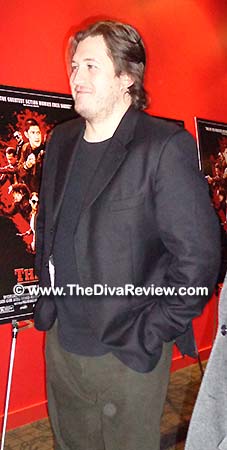 The
Lady Miz Diva: What were some of the challenges of making The Raid 2
bigger and better than the first film?
The
Lady Miz Diva: What were some of the challenges of making The Raid 2
bigger and better than the first film?
Gareth Evans: Some of the challenges were down to the idea that thereís a certain level of expectation now. And also we donít have the surprise element that we did on the first one. Nobody knew what we were doing, nobody knew who we were. Then all of a sudden - boom! Ė act two; now everyone knows what to expect. Iko {Uwais} was worried, he was concerned like, ďOkay, what are we going to do to make this different?í I was like, ďWeíve just gotta not think about it like that. Weíre gonna ignore that and get in the same creative head space as we were in the first movie.Ē Which is basically we were making that film in a bubble; nobody knew what we were doing. And so I said letís do the same thing again; rely entirely on our good instincts, whatever we feel is right for the film. As long as we come away from it and weíre happy, thatís great. If the audience are gonna follow us on this, in expanded universe, then great, thatís perfect. I said to Iko that I expected it to be a little bit more divisive this time around than it was on the first one.
LMD: Why did you think that?
GE: I get comments all the time on Twitter. I get people all the time telling me, ďDonít fuck it by putting too much drama in.Ē ďDonít fuck up by changing the format.Ē ďMake it another building film.Ē Iím like, ĎIím not doing any of that, so youíre going to be disappointed straight away.í So, itís that idea of wanting to make it something that hopefully fans of the original will embrace as well, but at the same time, itís gotta be something that we want to do and it had to be something that we want to embrace, as well. So in terms of that, it meant expanding our universe, spreading out more.
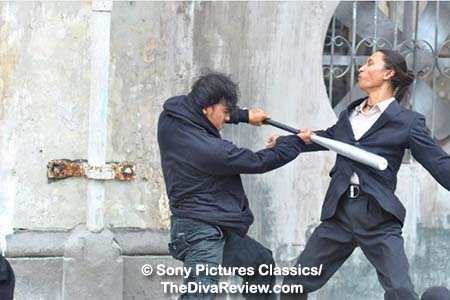 LMD:
I told your actors about watching this at the press screening and seeing
critics get up and take a walk during the more intense moments.
Realising this film will play to a larger audience, were you conscious
about how far you could go? What do you say to people who might
complain about the violence or the gore?
LMD:
I told your actors about watching this at the press screening and seeing
critics get up and take a walk during the more intense moments.
Realising this film will play to a larger audience, were you conscious
about how far you could go? What do you say to people who might
complain about the violence or the gore?
GE: Um, well, for them, thatís right. Itís down to each individual person. Some people are going to find it too violent. Thatís fine; itís not for them. Some films I donít like to watch because theyíre too sentimental. Thatís something I canít stomach, when itís really sentimental. So, thatís my taste.
Everyoneís going to have a different approach; some people are going to have a taste for it and embrace it and thatís fine. If somebodyís seen the first one, they know what theyíre getting. For me, itís not that much more violent than the first one, really. Itís just a different feel now. It kind of hits a little harder now.
My goal was never to make it disgustingly violent. I donít want to make it look repellent. Itís more about getting that shocked reaction; making the audience go *gasp* and then they realise that theyíve all done the same thing and then they laugh. Itís to create that levity within the action scene, cos it can be enjoyable, it can be entertaining. And so that was the goal.
LMD: I have to ask you about Iko and Julie {Estelle}, who I spoke with earlier today.
GE: Yeah, nightmare, arenít they? {Laughs}
LMD: Is there a point where you ask Iko to do something - a specific move or stunt - and he says, ďI canít do it?Ē
GE: No. Usually what will happen is itís the reverse; so if I tell Iko, ďOkay, thatís enough, now. Weíve gotta move on,Ē and he doesnít feel that we got the take, heíll be, ďOh, please, please, letís do one more take. One more take,Ē just to make sure that we get it. And IĎll be, ďOkay, Iíll give you one more take and no more than that.Ē And then if he fucks up again, Iíll be like, ďOkay, weíre done now,Ē and heíll say, ďOh, come on, one more take.Ē And Iíll be ďOkay, one more take and weíll move on,Ē and it ends up being 5, 6, 7, 8 more takes until we get it done.
I mean, we both have the same thing; we both want it to be perfect. We both design it in a way where we can do it. And the thing is, when it comes to the action, when it comes to the fighting, our whole goal is that we design it a way where itís grounded in reality. Where people watching it are not thinking itís incredulous. Itís not acrobatics; itís not somersaults and kicks where it stops being a fight, but itís like literally itís all real movements, and so we know that he can do everything.
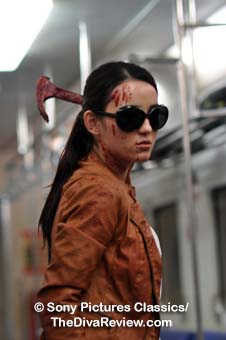 LMD:
Regarding Julie as Hammer Girl, I think sheís going straight into the
pantheon of excellent female action movie icons like Sigourney Weaver in
Aliens or the Kill Bill ladies. What do you think it is about women
doing action that makes people take more notice?
LMD:
Regarding Julie as Hammer Girl, I think sheís going straight into the
pantheon of excellent female action movie icons like Sigourney Weaver in
Aliens or the Kill Bill ladies. What do you think it is about women
doing action that makes people take more notice?
GE: Well, for me, itís like this, I wanted to present this character as the most cold-blooded bitch ever. I wanted her to be like this badass role and this thing of like, anything these boys can do, she can do - and do a hell of a lot better. That was interesting for me; there was this opportunity to kind of like have this moment where she gets to showcase this skill set. I hate that idea of the presumption of, ĎWell, itís a girl fighting, so itís going to be soft on the choreo,í cos a lot of people feel that, a lot of people say that on message boards. Just like people in martial arts sometimes when they talk about women being softer and not as strong, and ĎAw, the stunt guyís doing all the work.í And for me, I was like, ďNaw, fuck that. Thatís bullshit.Ē Cos you look at Yukari Oshima and you look at JeeJa Yanin; they can fight and they can fight really hard, as well.
And so for me it was a case of finding someone who could do that for us in Indonesia, and so when Julie came along and we started auditioning her for the role, I knew that she would go full on. If anything, she goes more full on than the guys, cos we did these hits to the people with the hammers and stuff; - usually when Iko does a hit to someone in the face, heíll swing really hard up to a point and then just before the impact, thereís like a snap {back}. Julie follows through, like full on! So youíve got all these male stunt guys who are trying to act like it didnít hurt them cos they want to be macho and shit and Iím like, ďLetís do another take,Ē and theyíre like *grimacing* ďOkay.Ē But itís great. Sheís a fucking star in the making, for sure.
LMD: This story was written before the 1st film. Did the creation of Redemption change any aspect of the story you had for Berandal?
GE: Yeah, if anything, it helped me with Berandal, cos with Berandal, the original concept was an ordinary guy who was overzealous in trying to protect someone and he ends up killing someone, so he gets sent to prison. And then when heís in prison, he befriends the son of a mob boss and then comes out and becomes an enforcer and thereís a gang war that kicks off. So for me, I couldnít find the motivation of the lead character to stay within that organisation when the shit hits the fan. So when it came to that, I needed to justify why he would stay; what would his reasons be? And so by doing The Raid 1 then, it gave me those ideas of what if we make this a sequel? What if we make this a continuation of the main character and heís forced to go undercover as a policeman in that world. Then it makes sense; heís not going to be able to leave when stuff goes wrong. He has to stay there. In a way, doing the first one helped inform that. But in a weird way as much as the first one helped inform the script of the sequel, we actually started doing choreography designs for Berandal before we started doing choreography for The Raid. That was a big difference between what we did on Berandal and The Raid 1, where thereís a huge shift in terms of the choreography and the aggression of it. Because weíd started on the Berandal choreography thinking we were going to get that made officially; that ended up informing the whole style of choreography that we put in The Raid 1, then. They both kind of go hand in hand so well together because they were both designed within the same frame of mind.
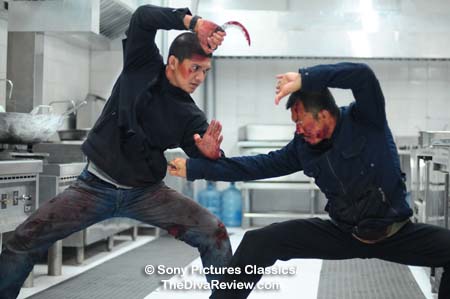 LMD:
Itís interesting because it seems like thereís a broadening of styles in
the choreo for Berandal. Like the kitchen fight seems to have elements
of Wing Chun to it.
LMD:
Itís interesting because it seems like thereís a broadening of styles in
the choreo for Berandal. Like the kitchen fight seems to have elements
of Wing Chun to it.
GE: For the kitchen fight, that was something we designed before The Raid 1, as well. We spent a hell of a long time designing that one. We spent a month and a half just to get the fight scene done, and then we spent another month and a half just to figure out the camera angles for that scene. We just had so much time on our hands, cos we couldnít get the budget for that film, and it was two years before we switched over to make The Raid 1. And so all of a sudden, this is a much bigger film and the action had to be bigger. I think that was always the plan anyway; we wanted to do this being, huge, massive movie.
Itís like this weird thing, itís like reverse-engineering the sequel out of it, where thereís so much which is pre-existing and it just seemed to fit as this idea of the growth of the story and the growth of the character and the growth of our scope. It just happened to be the case that we didnít have the money to do it and in a way, to be perfectly honest, Iím kinda glad we didnít because I donít think we were really ready to do that film until after Raid 1. So Iím kind of glad we didnít get it straight off.
LMD: You mentioned that fans on Twitter were vehemently against there being drama in this sequel. I think itís part of what makes this film superior to the previous one, which I loved. In your opinion, is good drama important to making a good action film?
GE: For me, itís important, itís like one of those things where even in the first movie it was kind of broad brush strokes maybe instead of building the character. It was that idea of trying to propel the plot forward all the time and not always be fight, fight, fight, but to find ways of building more tension-building moments. I guess Iíd been looking for a way to do a martial arts film where people donít just skip through to the fight. Iíve got so many martial arts movies from around the world; different directors, different actors, different fights, and I guarantee you probably eighty or eighty-five percent - maybe more than that Ė Iíll put them on and Iíll just jump to the fights straight away. I donít want to watch the film anymore.
Special films, I will, like Police Story or the Project A films; Iíll watch them from beginning to end, and Crouching Tiger {Flying Dragon} or House of Flying Daggers. Iíll watch them almost more for the drama, really. For Crouching Tiger, itís so beautiful. Iíve always wanted to establish that, where you wonít just jump to the fights when you see this film.
LMD: When I spoke with Iko, he mentioned choreographing his punches to match a certain rhythm. The editing in this film also feels very rhythmic. Do you play music or have music in your head when youíre editing?
GE: Yeah, absolutely, when it comes to the action sequences, itís not so much that we look for a certain piece of music, but we look for a rhythm, a tempo in order to design the fight scenes. So we all get together to design them and after a while you kind of get a sense of what the rhythm is, and what the time signature of the scene should be. It came around when I was watching Armour of God, the Jackie Chan film, and Iíve watched it many, many, many times over. This one time I was watching it and this was way back when I was doing research for the film, Merantau; I kind of took my head away for a second to go off to do a little bit of writing, and as I was writing, I kept hearing the film playing in the background, not paying attention to the visual. I realized all the percussive elements came from the punches, it was all the impact sounds and itís the way that Jackie Chan does those things; the design is so specific.
So when we designed our fight scenes, we decided to play around with the idea of using the elements of punches and kicks. Weíd listen to the scene listening to the rhythm of it and figuring out is it five, is it four, is it six? Whatís the time of it? Our composers, Fajar Yuskemal, Aria Prayogi and Joe {Joseph Trapanese}, they were basically in the position where they would watch the fight a couple of times and they would pick up the rhythm of where the blocks and kicks are, and I think that when they were writing the music, it was already kind of laid out for them.
LMD: When we met last week, I asked you what your favourite martial arts films were and you mentioned Police Story and Drunken Master 2 Ė I missed the 3rd title.
GE: It tends to change a lot, but I tend to say Fist of Fury a lot.
LMD: Not the Donnie Yen TV series, or the Jet Li remake?
GE: I love Fist of Legend, the Jet Li one. I think thatís an incredible film, but I gotta say I love Fist of Fury because it was one of the first ones I saw as a child and it completely blew me away.
LMD: You just talked about how the rhythm of Jackieís films affected your writing. How else have these films shaped what you do as a filmmaker? I saw a little bit of Jackie Chan influence in the bamboo construction site scene in Merantau.
GE: I think when it came to Merantau, I wanted to make a film that kind of paid respects to, or acknowledged some of those more typical martial arts films; like with the bamboo construction site because thatís usually a location in these types of films. But when it came to The Raid, it was its own beast; there was like a building, so that was more like Die Hard or Assault on Precinct 13. And then when it came to The Raid 2, it was whatever made sense in the story, as opposed to a response to a genre. I knew I wanted the film to have a restaurant. I knew I wanted to have this beautiful, sprawling banquet hall. Once I knew I was going to have it a restaurant, then the corridor space where Iko fights Baseball Bat Man and Hammer Girl; that was completely based off a real corridor that I saw in a Chinese restaurant here in Jakarta.
LMD: Was the car chase part of the original script?
GE: The car chase was in original script. The only thing that was new was the police procedural stuff.
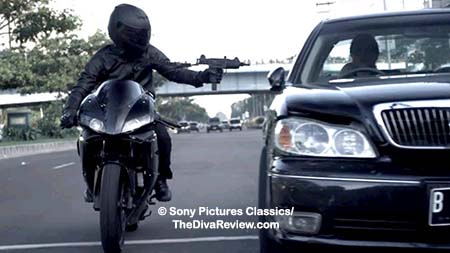 LMD:
What was the most difficult challenge about directing that amazing car
chase?
LMD:
What was the most difficult challenge about directing that amazing car
chase?
GE: To be honest, the hardest part of it was that I had originally seven days scheduled to shoot it, which was going to be tight anyway, and then finding out having never done this schedule before, that when you book to block a road in Indonesia to shoot a film, you donít get your full time there. You donít get a hundred percent of your time there. You only get a certain amount of hours to shoot a day. So we went up to like ten days, twelve days, and that was when we finished the project.
It was literally the most stressful thing in the world, cos you close the road and even though people know youíre going to do a stunt - weíve got police there, weíve got tape up, weíve got it all blocked off - but then youíve got the one guy on the motorbike who would just make it through somehow. We would be about to shoot the car stunts, and we would have to stop all of a sudden because we would see this motorbike just speeding up towards us. Those stressful moments where weíre watching the monitors, but at the same time weíve got people there watching all around the cars to make sure that nobody was gonna come towards us or from behind us so we could stop the take, just in case. But it was hell on earth to control that set. The fact that we got through it and nobody got hurt is a good thing, but it was so difficult to get it done. It was unlike anything weíve ever done before.
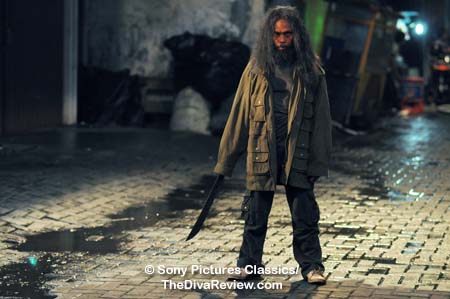 LMD:
I think fans of your previous films will be delighted at the return of
Yayan Ruhian, but itís possible that people might be confused: I didnít
understand he wasnít playing the same character in Redemption until I
rewatched the long take of him on the floor to see if his hand moved.
He is one connection to The Raid 1 and 2, but there are other
connections throughout your last three films: Iko plays someone called
Yuda named in both Merantau & Berandal. You made Yayan the name of the
villain in Merantau. Donny Alamsyah plays Ikoís brother in all three
films. Do you throw in these references to the previous films for the
fansí amusement, or are all the stories in this world interconnected in
a way?
LMD:
I think fans of your previous films will be delighted at the return of
Yayan Ruhian, but itís possible that people might be confused: I didnít
understand he wasnít playing the same character in Redemption until I
rewatched the long take of him on the floor to see if his hand moved.
He is one connection to The Raid 1 and 2, but there are other
connections throughout your last three films: Iko plays someone called
Yuda named in both Merantau & Berandal. You made Yayan the name of the
villain in Merantau. Donny Alamsyah plays Ikoís brother in all three
films. Do you throw in these references to the previous films for the
fansí amusement, or are all the stories in this world interconnected in
a way?
GE: Ah, you noticed that about Yuda. Itís nice you spotted that. Thereís no real specific reason for it. {Laughs} The thing about Donny playing IkoĎs brother in all three films is just purely coincidental. Originally in the very first script for The Raid 1, Iíd cast Iko, Iíd cast Donny in the role, but he wasnít going to be a brother, he was going to be an undercover cop and he was infiltrating that building. And then I started to think, why would he {Iko/Rama} risk his life and his wife and his child for another undercover cop? But what if itís his brother? And I thought, okay, well, he just played his brother in the last film, but it doesnít matter, itís okay. And later, when I was writing The Raid 2, I thought, well, what should his alter-egoís name be and thought, well, fuck, I should use Yuda - it was the name of his character in Merantau. And I thought, well, what if somebody asks me why, and to be honest, itís just fuck it, why not? There is nothing wonderfully, pretentiously self-reverential about it; itís just like, yeah, why not, it doesnít matter.
Some of our more hardcore fans, they noticed that the metal box that we used for the tapes in Raid 1 and Raid 2, itís the same metal box that Iko pulls out of the ground in Merantau. Do you know why thatís the case? Hereís what the theory was of some of our fans; their theory was that the little boy in Merantau that gets saved ends up becoming Tama {The villain in Raid 1}. The real reason is, when I asked my art department for metal box, that was the only metal box that they fucking had. I went, ďSeriously? Thatís the only fucking thing youíve got? The hell?Ē And then one of the guys in the art department wanted to spray paint it black, but I said, ďDonít do that. Letís just keep it the same.Ē They said, ďWhy not?Ē And I said, ďBecause then fans in America will try to figure it out and come up with all sorts of conspiracy theories. Letís just keep it the same, why not?Ē
And the thing about Prakoso and Yayan coming back to play all these roles in the films - well, this is a spoiler - Yayan, I just think heís really good at dying in my movies. Itís been three times in a row, now. But to be honest, he such a huge talent, heís got such a huge skill set about him; itís kind of like this, whenever I write the film, I feel compelled to direct it. When he designs choreography, I guess he must have that feeling of being compelled to perform it. Some part of that performance must be his. If I didnít cast him at all, and I had him just as a choreographer, Iíd feel like I would be not only wasting his time in that he didnít get to perform in the film, but also denying myself of being able to use one of the most talented fighters that weíve got here. So for me, itís a no-brainer. Itís like, yeah, okay, he does look similar. No matter how much we try to change his appearance, he still looks similar. But you know what, his performance is like a 180 on Mad Dog - totally different, this performance.
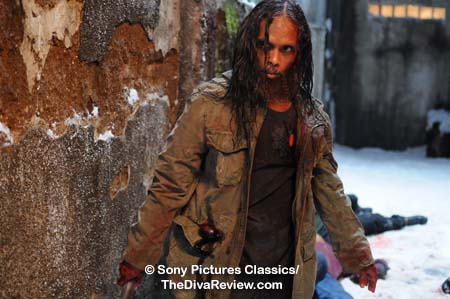 LMD:
I really wanted to know more about Prakoso, Hammer Girl and Baseball Bat
Man. Julie enlightened me as to the backstory of Hammer Girl and
Baseball Bat Man, but I wondered if youíve thought about doing shorts or
perhaps animated webtoons about their histories?
LMD:
I really wanted to know more about Prakoso, Hammer Girl and Baseball Bat
Man. Julie enlightened me as to the backstory of Hammer Girl and
Baseball Bat Man, but I wondered if youíve thought about doing shorts or
perhaps animated webtoons about their histories?
GE: Well, I was thinking of doing a comic book, like an origins book. It would be The Raid 1 and The Raid 2 combined, but within that, there would be chapters on the characters. I already have the backstory for Hammer Girl and Baseball Bat Man. I have a backstory even for Bejo and Prakoso, as well. Prakoso, his back story is, go back twenty years, that guy was this smooth, smart looking fucking guy. Short hair, shaved beard.
LMD: That explains his gorgeous wife.
GE: But thatís how he got her, you know? He didnít get her like he is now. The idea is she was like a young girl at the time, a seventeen or eighteen-year-old girl that was working in the club and he was there and he was like on Bangunís level; suave, sophisticated. And then they get together and he wows her and they fall in love and have this child together and she has no idea about what he actually does. Then one night theyíre in the car together driving home with the child in the back seat, and out of nowhere, he comes under attack. So he really just goes on reflex, he starts pounding this guy, beating the shit out of this person that tried to kill him. Itís raw and its aggressive, itís rough and itís completely violent and all the while he doesnít even realize that the monster that heís turning into is being witnessed not only by his wife, but by his son in the back seat. And thatís the moment that she realizes just who he is and that she canít be with him. That was a really kind of important backstory for me to figure that out; it was like, ĎOkay, now it makes sense that youíve got this remarkably beautiful wife.í
LMD: I think that was a mystery to everyone.
GE: And then, what the fuck? Are you still using a pager?
~ The Lady Miz Diva
March 17th & 22nd, 2014
Click here to read our Exclusive Interview with The Raid 2 stars Iko Uwais and Julie Estelle
© 2006-2022 The Diva Review.com
|
|











































